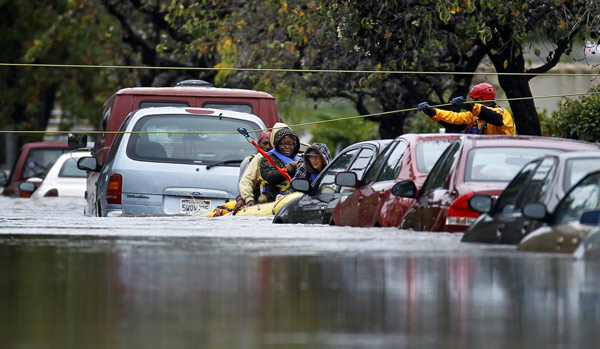Society
Scientists connect global warming to extreme rain
Updated: 2011-02-17 13:04
(Agencies)
WASHINGTON - Extreme rainstorms and snowfalls have grown substantially stronger, two studies suggest, with scientists for the first time finding the telltale fingerprints of man-made global warming on downpours that often cause deadly flooding.
|
 Emergency water rescue crew members ferry hotel guests from their hotel after heavy rains and flooding trapped guests staying at a hotel in San Diego, California Dec 22, 2010. [File photo/Agencies] |
Two studies in Wednesday's issue of the journal Nature link heavy rains to increases in greenhouse gases more than ever before.
One group of researchers looked at the strongest rain and snow events of each year from 1951 to 1999 in the Northern Hemisphere and found that the more recent storms were 7 percent wetter. That may not sound like much, but it adds up to be a substantial increase, said the report from a team of researchers from Canada and Scotland.
The change in severity was most apparent in North America, but that could be because that is where the most rain gauges are, scientists said.
Both studies should weaken the argument that climate change is a "victimless crime," said Myles Allen of the University of Oxford. He co-authored the second study, which connected flooding and climate change in Britain. "Extreme weather is what actually hurts people."
Jonathan Overpeck, a University of Arizona climate scientist, who did not take part in either study, praised them as sensible and "particularly relevant given the array of extreme weather that we've seen this winter and stretching back over the last few years."
Not all the extreme rain and snow events the scientists studied cause flooding. But since 1950, flooding has killed more than 2.3 million people, according to the World Health Organization's disaster database.
The British study focused on flooding in England and Wales in autumn of 2000. The disaster cost more than $1.7 billion in insured damages and was the wettest autumn for the region in more than 230 years of record-keeping.
Researchers found that global warming more than doubled the likelihood of that flood occurring. Similar studies are now under way to examine whether last year's deadly Russian heat wave and Pakistan floods -- which were part of the same weather event -- can be scientifically attributed to global warming.
For years scientists, relying on basic physics and climate knowledge, have said global warming would likely cause extremes in temperatures and rainfall. But this is the first time researchers have been able to point to a demonstrable cause-and-effect by using the rigorous and scientifically accepted method of looking for the "fingerprints" of human-caused climate change.
The scientists took all the information that shows an increase in extreme rain and snow events from the 1950s through the 1990s and ran dozens of computer models numerous times. They put in the effects of greenhouse gases -- which come from the burning of fossil fuels -- and then ran numerous models without those factors. Only when the greenhouse gases are factored in do the models show a similar increase to what actually happened. All other natural effects alone don't produce the jump in extreme rainfall. Essentially, the computer runs show climate change is the only way to explain what's happening.
In fact, the computer models underestimated the increase in extreme rain and snow. That is puzzling and could be even more troubling for our future, said Michael Oppenheimer of Princeton University, who was not part of the study.
Similar fingerprinting studies have found human-caused greenhouse gas emissions triggered changes in more than a dozen other ecological ways: temperatures on land, the ocean's surface, heat content in the depths of the oceans, temperature extremes, sea level pressure, humidity at ground level and higher in the air, general rainfall amounts, the extent of Arctic sea ice, snowpack levels and timing of runoff in the western United States, Atlantic Ocean salinity, wildfire damage, and the height of the lower atmosphere.
All those signs say global warming is here, said Xuebin Zhang, a research scientist for the Canadian government and co-author of the Northern Hemisphere study. "It is affecting us in multiple directions."
Most of the 10 outside climate experts who reviewed the papers for The Associated Press called the research sound and strong.
However, climate scientist Jerry North of Texas A&M University, while praising the work, said he worried that the studies were making too firm a connection based on weather data that could be poor in some locations. But Francis Zwiers of the University of Victoria, a lead author of the study with Zhang, said the data was from National Weather Service gauges and is reliable.
"Put the two papers together and we start to see an emerging pattern," said Andrew Weaver of the University of Victoria, who wasn't part of either study. "We should continue to expect increased flooding associated with increased extreme precipitation because of increasing atmospheric greenhouse gas. And we have no one to blame but ourselves."
E-paper

Ear We Go
China and the world set to embrace the merciful, peaceful year of rabbit
Preview of the coming issue
Carrefour finds the going tough in China
Maid to Order
Specials

Mysteries written in blood
Historical records and Caucasian features of locals suggest link with Roman Empire.

Winning Charm
Coastal Yantai banks on little things that matter to grow

New rules to hit property market
The State Council launched a new round of measures to rein in property prices.




